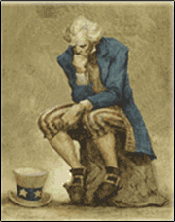
–>
July 13, 2022
The issue of who runs this country is one of the central issues, if not the central issue, of the 21st century.
‘); googletag.cmd.push(function () { googletag.display(‘div-gpt-ad-1609268089992-0’); }); }
Begin with the Preamble to the U.S. Constitution. “We the People of the United States, in Order to form a more perfect Union, establish Justice, insure domestic Tranquility, provide for the common defence, promote the general Welfare and secure the Blessings of Liberty to ourselves and our Posterity do ordain and establish this Constitution of the United States of America.”
The people’s representatives meeting at the Constitutional Convention in 1787 clearly considered the sovereign power of this country to reside with its people acting through their elected representatives in the State and Federal governments. That is the very definition of a constitutional republic.
Many constitutional conservatives are thus rightly annoyed when “democracy” is used to refer to this country’s form of government. The framers of our Constitution considered “democracy” to be a discredited concept because they knew the classical history of Athens. It did not take long before Athens turned into an oligarchy with imperial ambitions to conquer other city-states.
‘); googletag.cmd.push(function () { googletag.display(‘div-gpt-ad-1609270365559-0’); }); }
The authors of our Constitution were also unimpressed with how the republican form of government had worked out in ancient Rome. The citizens of Rome (admittedly not all of the people) for centuries had ruled themselves through elected senators who in turn appointed officers to administer the government. Over time the rule of law in Rome succumbed to a power grab by a select few, often successful generals (e.g., Julius Caesar who conquered what is now France). Caesar put an end to the charade of republican government. For centuries thereafter Rome preserved the Senate as an ineffectual formality with the real power held by the emperor and, after awhile, his Praetorian Guard, who became virtual “kingmakers.”
The lesson learned from Roman history, reflected in our Constitution, was that vesting a government’s sovereign power in one leader, whether an emperor or a chief executive, will most likely lead to a dictatorship.
Therefore, when one asserts that the President of the United States “runs the country” one is making a categorical error. Per Article Two of the Constitution, the president is the chief executive who is responsible for the exercise of the enumerated powers vested in the executive branch of the federal government. The other branches (legislative and judicial) are vested with their own powers. Just as important, the States and the people, per the Tenth Amendment to the Constitution, have reserved to them “the powers not delegated to the United States by the Constitution nor prohibited by it.”
 James Madison, one of the principal designers of our constitutional form of government, envisioned the separation of powers between the three branches of the federal government and also between the federal government and the state governments to be the principal safeguard against the catastrophes that befell ancient Athens and Rome: rule by oligarchs or rule by a dictator.
James Madison, one of the principal designers of our constitutional form of government, envisioned the separation of powers between the three branches of the federal government and also between the federal government and the state governments to be the principal safeguard against the catastrophes that befell ancient Athens and Rome: rule by oligarchs or rule by a dictator.
Where do we stand as we begin the third decade of the 21st century? Is the United States still a constitutional republic? As of now the signs are mixed.
The U.S. Supreme Court’s took a step in the right direction last month with its decision in West Virginia v. Environmental Protection Agency. Without getting too technical, the Court’s opinion prevented the EPA from expanding its authority to regulate emissions from power plants per the Clean Air Act to enable it to restructure the overall mix of electricity generation in the U.S. from 38% to 27% coal by the year 2030. The power to rewrite legislation is supposed to be exercised only by Congress and not an agency in the Executive Branch.
‘); googletag.cmd.push(function () { googletag.display(‘div-gpt-ad-1609268078422-0’); }); } if (publir_show_ads) { document.write(“
Another positive development was the decision of the Supreme Court in Dobbs v. Jackson Women’s Health Organization. Many people wrongly construe the decision as prohibiting abortion. Actually, in overturning Roe v. Wade, the Court reversed a power grab by the judicial branch when a majority of that court virtually amended the Constitution to create a right to an abortion and to prohibit any state from exercising its authority to regulate the medical procedure and, if it so chose, protect the life of the unborn child by prohibiting abortion before or after certain stages in the pregnancy.
On the other hand, there is an ongoing power grab by the Biden administration to interfere with the administration of elections. That authority is given to the legislatures of the states by Article I, Section 4 of the Constitution. On March 7, 2021 President Biden issued an executive order directing all 600 federal agencies to create plans for increasing voter registration and turnout in the next two elections. The result: many agencies intend to turn federal facilities, particularly those that deliver federal benefits, into voter registration agencies. However, the National Voting Rights Act gives the authority to designate new voter registration agencies to the states and not the executive branch.
In 2022 and in 2024 the states will face a squeeze play as the federal government and left-wing non-profit organizations try to take over voter registration and election administration. In 2020 Mark Zuckerberg, the Facebook tycoon, funneled $450 million through a left-wing foundation to change voter turnout and election administration in swing states. Read the book Rigged by Mollie Hemingway for the details. He succeeded and should be expected to repeat the effort in 2024.
Benjamin Franklin allegedly pronounced that the Declaration of Independence gave us “a republic if we can keep it.” Will we have a constitutional republic when we reach the 225th or 250th anniversary of the Declaration? My answer is that it remains to be seen. It is going to be a great comeback victory if the power grab by the Democrats in Congress, the executive branch, and the federal judiciary is to be thwarted.
Image: RawPixel
<!– if(page_width_onload <= 479) { document.write("
“); googletag.cmd.push(function() { googletag.display(‘div-gpt-ad-1345489840937-4’); }); } –> If you experience technical problems, please write to [email protected]
FOLLOW US ON
<!–
–>
<!– _qoptions={ qacct:”p-9bKF-NgTuSFM6″ }; ![]() –> <!—-> <!– var addthis_share = { email_template: “new_template” } –>
–> <!—-> <!– var addthis_share = { email_template: “new_template” } –>




